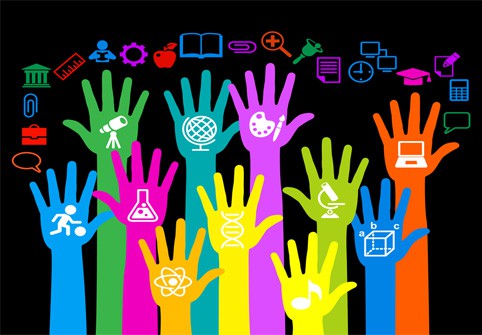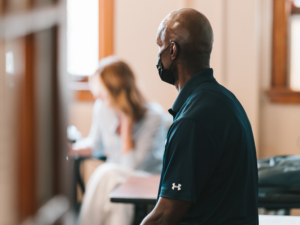#SXSWedu: It’s Hump Day!

It was another powerful day at #SXSWedu and the weather seems to be making a turn for the warmth Austin is known for. We’ve made it through half the week and still have another great day of programming ahead of us tomorrow. Aside from great hallway conversations and lounge meet-ups our team enjoyed a jam packed day of sessions. Here is a quick recap of what we heard today. If you missed any of our other coverage here’s the latest:
Writing = Thinking. Wednesday kicked off with a session featuring College Board’s David Coleman, author Robert Caro, education journalist Peg Tyre and a teacher from New York. “We will not close the achievement gap until we close the literacy gap,” said Tyre. The session highlighted the importance and power of great analytical writing. Coleman announced partnership with The Atlantic and College Board that will create a prize for student writing modeled after the Pulitzer prize in writing. In the months to come we’ll hear more about College Board’s commitment to analytical writing. Coleman wrapped the session with powerful words, “United in the notion that for students to write with care, is perhaps the single most preparation for college, career and future work.”
Time to Get Connected. According to Richard Culatta from the US DOE, about 70% of schools don’t have the broadband connection needed to facilitate online learning experiences. The ConnectEd initiative ensures that all schools will have access to broadband Internet in 5 years. In addition the initiative is focused on ensuring access to affordable devices, phenomenal digital content, and making sure teachers are prepared and supported to transition to digital learning. Culatta highlighted the importance of public-private partnerships in ensuring a smooth transition to digital learning. Several companies have made large education investments in the past few months to education including; Apple’s 100 million commitment to education, Microsoft making their operating system free to schools, and Adobe made a 300 million donation to ensuring students can create digital content.
Baltimore County Schools by Superintendent Dallas Dance walked the audience through best practices his team has learned from a digital conversion in his district. “We don’t have a enough rich digital content”, says Dance. He’s excited about the work of ConnectED to ensure high quality digital content is available to schools.
Open Access for ALL. This morning student scientist Jack Andraka gave a brief insight into his study and creation of a more inexpensive and sensitive testing tool for the early detection of pancreatic, ovarian and lung cancers. Jack, driven by the loss of a loved one set out to find a way to help better detect pancreatic cancer earlier on and in a more cost effective way. Through his journey one summer and throughout a school year, Jack discovered the expense of scientific research. Many studies and publishings are set up with paywalls requiring payment before access. Although some articles may only be $35, when you’re a 15 year old, studying 8000 protein strands- the costs can add up quickly. Jack is advocating for open access for all. Jack expressed his mission well when he said “imagine if we could live in a knowledge democracy where superficial factors don’t matter and no matter what you’d have access to scientific articles. Knowledge shouldn’t be a commodity and access should be a human right.”
No Silver Bullet. Wendy Kopp, founder of Teach For America and Teach For All kicked off the afternoon with a great discussion about how improving education outcomes will improve economic conditions. Vouchers, charters, and technology innovations have all been labeled silver bullets but have proven to not be the panacea some hopped. Marginalized students are often struggling through a cycle of factors that prevents them from succeeding in education. Kopp suggested that to break the cycle we need to have stronger communication, stronger schools and more informed beliefs, policies and practices. Teach For All is working to channel the valuable human capital resources into schools that need the most support. “Its going to take a massive force to take on such a complicated problem. It will take working from every direction in every corner of the world,” says Kopp. Kopp ended her remarks posing this statements from Teach For All, “One day, all children will have the opportunity to attain an excellent education.”
Disrupt With Montessori. What does school look like? It is not only time to ask that question, but it is even more necessary to ask, “should it?!” What is education for and why do we need this? When we are in the middle of technology revolution, the answer to this question may have been answered a very long time ago by Maria Montessori. The pedagogy has already produced many innovative minds whose creative thinking has changed the world, yet it still not a mainstream solution. Montessori’s largest growth is currently in the public sector but is definitely a grassroots movement. Really, the only way education can really rebuild is if parents demand it. Montessori is not a “program” you can order- it is scientific pedagogy, an ecosystem in itself, that stems from development and student need. Although it originated long before the technology revolution, it is one of the most effective models for instilling curiosity, creativity and 21st century thinking in today’s students.
Hitting the #SpecEd Bullseye. We talk personalized learning quite often and it’s been a theme here at SXSW but what about special education (SPED) students? Presence Learning Co-CEO and co-founder Clay Whitehead started of his “Individualization for Students with Special Needs” session asking three participants to come up and create a paper airplane with the goal of hitting a bullseye. The question was then asked- why can’t we hit the SPED bullseye? What are we missing? We spend two times as much on SPED students than on general education students, in fact we spend 100 billion a year and still have twice the dropout rate. It’s time to get it right.
Closing the Talent Gap. An experienced panel from around the globe gathered to talk about the “talent” gap and developing effective, great teachers world wide. We need great teachers to create personalized learning in their classrooms but there’s not a model or professional development that’s scalable on a global level. In the U.S. we spend more than 12 billion dollars a year on professional development but the data shows little to no impact. How can we create a system or infrastructure of teachers to interact with each other? Susan Mann, CEO of Education Services Australia (ESA), established to support the delivery of national priorities and initiatives in schools and training to participating teachers offered the resource as a great example of teacher PD on a scalable level. ESA offers a great platform called “Scootle” that offers digital resources and professional learning networks to educators in Austrailia. Using Scootle’s search functionality, users can search by curriculum and apply filters to uncover a wealth of resources. Since its launch, Scootle has had great immense growth and teachers are continuing to use it over time. The technology that we have creates “a real definition of professional learning that we’ve never had the opportunity for” Susan explained. It’s time to take PD to a global level and see the opportunities that can be unlocked by using EdTech to connect our educators.
Presence Learning is a Getting Smart Advocacy Partner.





0 Comments
Leave a Comment
Your email address will not be published. All fields are required.